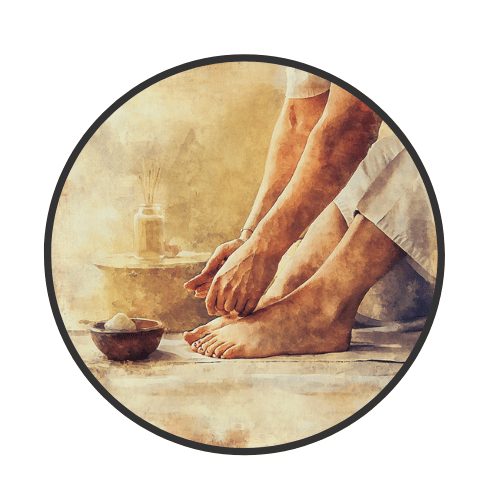”To cure disease after it has appeared is like digging a well when one already feels thirsty, or forging weapons after the war has already begun.” -Nei Jung
In the West, we tend to think of ourselves only as physical beings. In actuality, we’re energy beings that have attracted matter to give us form. When we think of ourselves this way, it’s easy to understand that disruption in our body’s flow of energy could then cause physical imbalance.
Acupressure, like acupuncture, is based on the principles of traditional Chinese medicine. Traditional Chinese medicine (TCM) developed from the belief that Chi (energy) is concentrated along meridians (channels) within the body. Meridians are the fundamental physical pathways through which Chi flows, connecting superficial areas of the body to internal areas. They are named according to the organ or system to which they are most directly connected.
Along each meridian are points that are often referred to as “gates.” If a gate is closed, the Chi cannot move freely through the meridian. Conversely, if a gate doesn't control the flow, the Chi in that area becomes deficient. Through the use of fingers (acupressure) or needles (acupuncture), these gates can be adjusted to promote the smooth flow of Chi throughout the body, thus encouraging the body to operate in harmony with itself.
How to Administer Acupressure
- Use deep, firm pressure to hold and stimulate each point for approximately 3 minutes. It should hurt a little at first and the pain should gradually diminish.
- When holding acupoints, try to relax in a comfortable position, close your eyes, and breathe deeply.
- Repeat as often as you like; there is no limit to the number of times a day you can perform acupressure.
- It’s important to drink plenty of room-temperature water after performing acupressure, to help clear away any toxic substances in the body.
Eight commonly used Acupressure points:
Gallbladder 20 (GB20): Gates of Consciousness
This point is recommended for headache, migraine, eye blurriness or fatigue, ankle pain, side ache, shoulder pain, low energy, and cold/flu symptoms. It is located at the meeting-place of the base of the skull and top of the neck - just lateral to the muscle tendon.
Gallbladder 21 (GB21): Shoulder Well
This point is located by pinching the shoulder muscle with your thumb and middle finger and is commonly used for stress, nervousness, irritability, fatigue, facial pain, headaches, toothaches and neck pain. Use with caution on pregnant women.
Pericardium 3 (PC3): Marsh at the Bend
You can find this point located on the inside of the arm, at the lower edge of the elbow crease when the arm is bent. PC3 is an emotional balancing point, and is connected to nervousness, anxiety, and irritability. It also helps relieve nausea, wrist pain, elbow pain, and chest discomfort. It moves and cools blood, dispelling stasis.
Pericardium 7 (PC7): Great Hill
This point is located in the middle of the crease of the wrist. PC7 works to calm the mind and clear heat. It is commonly used to treat insomnia, convulsions, too much or too little sweat, hot flashes, and foul breath.
Pericardium 6 (PC6): Inner Gate (Healing Point)
This point is located three finger-widths below the wrist on the inner forearm in between the two tendons. It can help relieve nausea, carpal tunnel syndrome, upset stomach, vomiting, hiccups, motion sickness and headaches and is even used for regulation of heart palpitations.
Large Intestine 4 (LI4): Joining the Valley (Gates of Pain)
This point is found in the web of the thumb and index finger and is good for stress, frontal headaches, constipation, depression, analgesic for pain, and balances gastrointestinal. However, as a word of precaution, it can induce labor and must never be used during pregnancy. Alternative: Hold index finger.
Spleen 6 (SP6): 3-Yin Crossing
This point is located on the inside of the leg, four finger-widths above the ankle in the depression under the tibia bone. This point can be very helpful for many urologic and pelvic disorders. Regulates menstrual cramps, aids in water retention, as well as fatigue and insomnia. Avoid during pregnancy.
Liver 3 (LV3): Great Surge (Gates of Pain)
You need to take off your shoe to find this point. It is found in the depression below the web between your big toe and second toe. This is an excellent area to stimulate for stress, low back pain, high blood pressure, limb pain, insomnia and emotional upset.
Congratulations! You’ve activated your body’s own restorative power! Here’s to better health, balance, and well-being. Caution: If you have a serious or life-threatening illness such as heart disease or cancer, or if you are pregnant, please consult with your physician before practicing Acupressure.
Disclaimer: This article is for informational purposes only. The information in this article is not intended to diagnose, treat, cure, or prevent disease.








Leave a comment
All comments are moderated before being published.
This site is protected by hCaptcha and the hCaptcha Privacy Policy and Terms of Service apply.